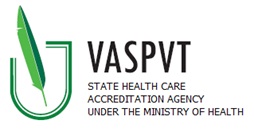Orthopaedic devices
Provision of orthopaedic devices for insured persons is important both for the insured person and the state, as a properly adapted orthopaedic device may partially or sometimes fully restore lost function for the disabled person, improve their quality of life, give them more opportunities to live and work independently, thus leading to favourable economic effect. It should be noted that priority sub-classes (prosthesis systems for arms and legs) include orthopaedic devices that are reimbursed 100% from the budget of the Compulsory Health Insurance Fund, thus patients do not need to pay any surcharge. The right to obtain state support for orthopaedic device purchase is only granted to insured persons.
Prescriptions for the orthopaedic devices can be issued by the following physician/specialists:
- surgeons
- orthopaedist traumatologists
- neurologists
- neurosurgeons
- physical medicine and rehabilitation physicians
- rheumatologists
- plastic and reconstructive surgery surgeons.
The physician informs the insured person
about the rules for purchase of orthopaedic device and reimbursement and gives
them a list of orthopaedic enterprises, which have signed agreements with the National
Health Insurance Fund regarding the supply of orthopaedic devices to insured
persons.
Only the costs for orthopaedic devices
produced as per order in these enterprises will be reimbursed.
Following the decision of the physician
regarding the necessity for an orthopaedic device for the insured person, only
devices listed in the lists of orthopaedic aids and their reference prices,
approved by the Minister of Health are reimbursed according to reimbursement
levels.
Ways of reimbursement:
- When orthopaedic devices are reimbursed to the patient via orthopaedic enterprises. This applies when the patient gets the orthopaedic device for free and the National Health Insurance Fund pays the orthopaedic enterprise directly.
- A different method is applied when demands for orthopaedic devices by individual subclasses exceed the funds allocated for a certain period; in this case the insured person may buy the orthopaedic device themselves and these costs will later be reimbursed directly to that person. This method is regulated by individual clauses of the inventory.
Surcharges: Surcharge for partial
reimbursement – this surcharge is paid to the orthopaedic enterprise (one point is
equal to one Litas), if partial reimbursement of orthopaedic device is foreseen
by legal acts.
Surcharge for technological peculiarities – this surcharge
is paid to the orthopaedic enterprise according to part 5 of article 49 of the Law
on Health System, if the insured person prefers an orthopaedic device, which is
more expensive due to technological peculiarities, compared to orthopaedic
device indicated for the same purpose, listed in the list of reimbursable orthopaedic
aids, approved by the Minister of Health. The difference in price between the more
expensive orthopaedic device and the reference price of orthopaedic device
listed in the above mentioned lists should be paid to the orthopaedic
enterprise. Surcharge for technological peculiarities may be applied after the
insured person or their legal representative confirms in writing that they have
been informed about the possibility to order orthopaedic device at a reference
price and indicates their decision to choose more expensive materials or
technologies.
Persons who have the right to obtain reimbursable
orthopaedic device and who wish to have the it earlier rather than having to
wait their turn on the waiting list until the required orthopaedic device is produced,
may pay for it themselves and be reimbursed later. A request for reimbursement
should be submitted to the National Health Insurance Fund by post, or courier
or the request can be submitted in person by a representative of the insured
person.
What documents are needed:
- request to reimburse the costs of orthopaedic device;
- request to produce reimbursable orthopaedic device;
- invoice issued by the orthopaedic enterprise and paid by the insured person;
- copy of the orthopaedic device order sheet.
Orthopaedic device technical maintenance services until the new device is available are provided free of charge, i.e. by the orthopaedic enterprises.
Disabled persons who are not able to go to
the orthopaedic enterprise due to their health condition, as well as
in-hospital patients are supplied with orthopaedic device at their places of
residence, places of treatment, or foster homes.







